A Report on Complex Project Management and Climate Change Factors
VerifiedAdded on 2023/03/17
|9
|2019
|44
Report
AI Summary
This report delves into the intricacies of complex project management, specifically focusing on climate change projects. It identifies and analyzes various factors influencing project success, including multiple stakeholders, ambiguity of project features, significant authority influences, and unknown project features. The report examines the impact of dynamic project governance, significant external influences, and the use of both new and not-yet-developed technologies. Furthermore, it addresses significant social influences, highly regulated environments, and project duration exceeding the cycle of relevant technologies. A Rader diagram visually represents these factors, providing a comprehensive overview of the challenges. The report uses a complexity factor to assess the impact of each element. The references cited support the findings.
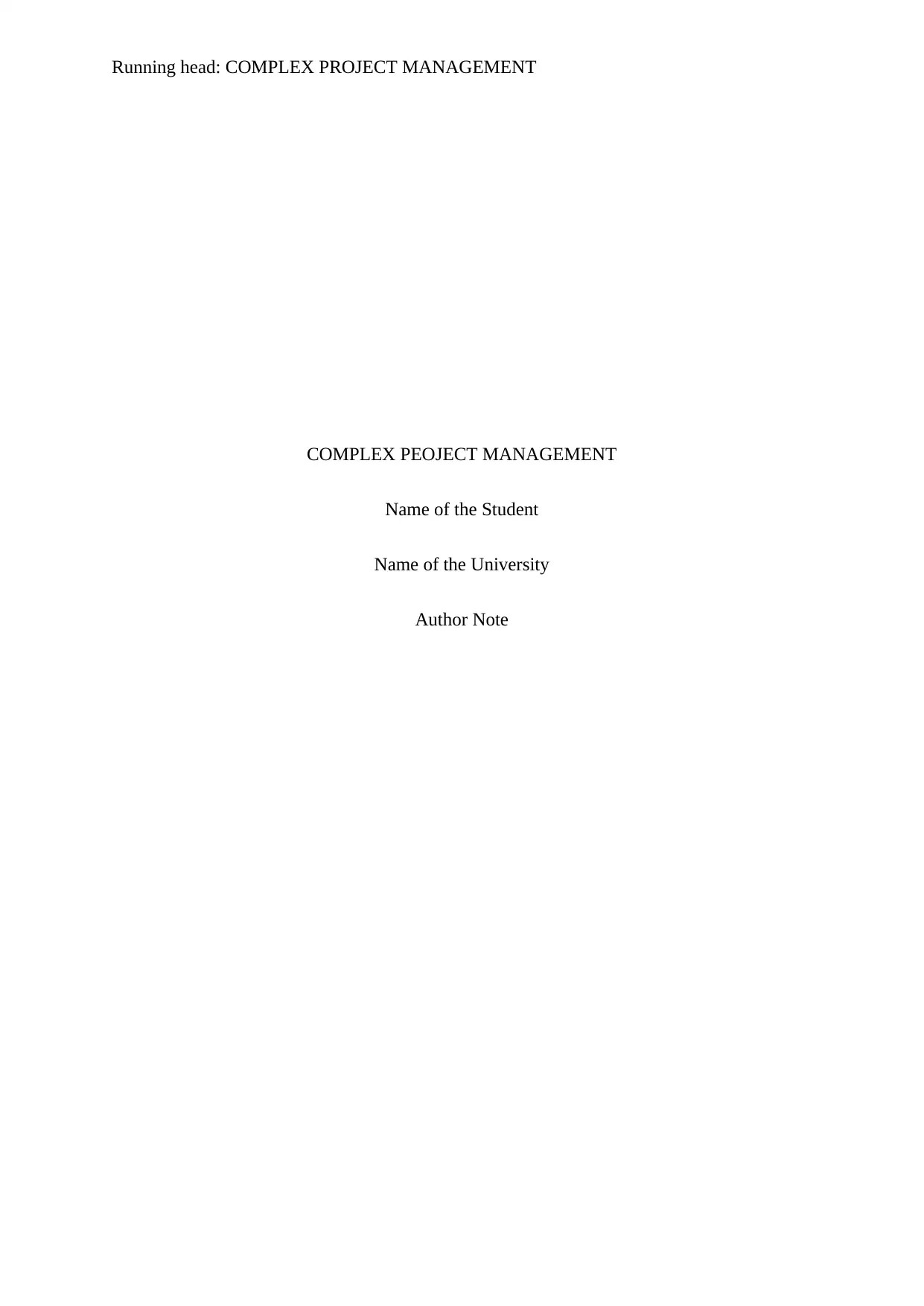
Running head: COMPLEX PROJECT MANAGEMENT
COMPLEX PEOJECT MANAGEMENT
Name of the Student
Name of the University
Author Note
COMPLEX PEOJECT MANAGEMENT
Name of the Student
Name of the University
Author Note
Paraphrase This Document
Need a fresh take? Get an instant paraphrase of this document with our AI Paraphraser
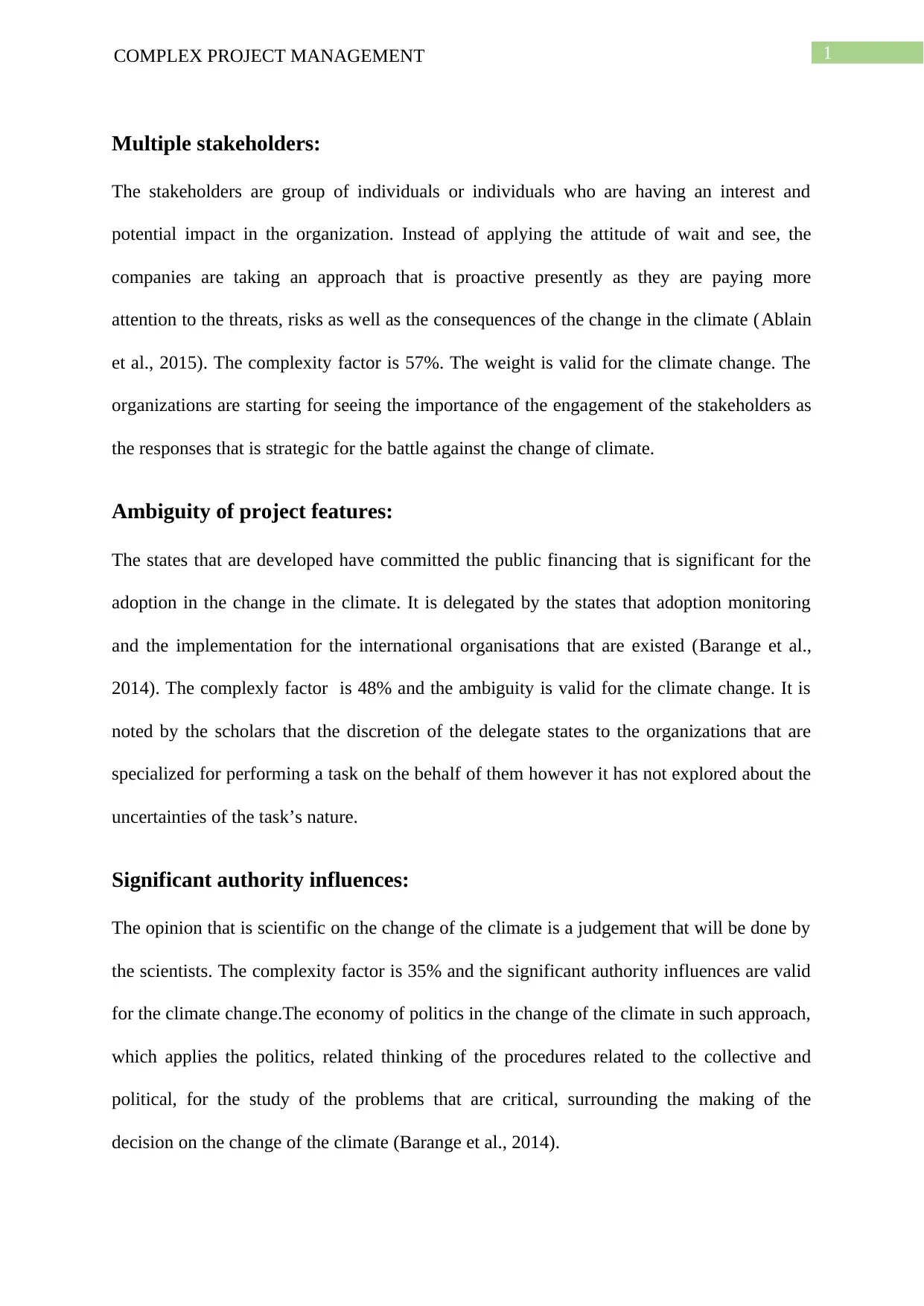
COMPLEX PROJECT MANAGEMENT 1
Multiple stakeholders:
The stakeholders are group of individuals or individuals who are having an interest and
potential impact in the organization. Instead of applying the attitude of wait and see, the
companies are taking an approach that is proactive presently as they are paying more
attention to the threats, risks as well as the consequences of the change in the climate (Ablain
et al., 2015). The complexity factor is 57%. The weight is valid for the climate change. The
organizations are starting for seeing the importance of the engagement of the stakeholders as
the responses that is strategic for the battle against the change of climate.
Ambiguity of project features:
The states that are developed have committed the public financing that is significant for the
adoption in the change in the climate. It is delegated by the states that adoption monitoring
and the implementation for the international organisations that are existed (Barange et al.,
2014). The complexly factor is 48% and the ambiguity is valid for the climate change. It is
noted by the scholars that the discretion of the delegate states to the organizations that are
specialized for performing a task on the behalf of them however it has not explored about the
uncertainties of the task’s nature.
Significant authority influences:
The opinion that is scientific on the change of the climate is a judgement that will be done by
the scientists. The complexity factor is 35% and the significant authority influences are valid
for the climate change.The economy of politics in the change of the climate in such approach,
which applies the politics, related thinking of the procedures related to the collective and
political, for the study of the problems that are critical, surrounding the making of the
decision on the change of the climate (Barange et al., 2014).
Multiple stakeholders:
The stakeholders are group of individuals or individuals who are having an interest and
potential impact in the organization. Instead of applying the attitude of wait and see, the
companies are taking an approach that is proactive presently as they are paying more
attention to the threats, risks as well as the consequences of the change in the climate (Ablain
et al., 2015). The complexity factor is 57%. The weight is valid for the climate change. The
organizations are starting for seeing the importance of the engagement of the stakeholders as
the responses that is strategic for the battle against the change of climate.
Ambiguity of project features:
The states that are developed have committed the public financing that is significant for the
adoption in the change in the climate. It is delegated by the states that adoption monitoring
and the implementation for the international organisations that are existed (Barange et al.,
2014). The complexly factor is 48% and the ambiguity is valid for the climate change. It is
noted by the scholars that the discretion of the delegate states to the organizations that are
specialized for performing a task on the behalf of them however it has not explored about the
uncertainties of the task’s nature.
Significant authority influences:
The opinion that is scientific on the change of the climate is a judgement that will be done by
the scientists. The complexity factor is 35% and the significant authority influences are valid
for the climate change.The economy of politics in the change of the climate in such approach,
which applies the politics, related thinking of the procedures related to the collective and
political, for the study of the problems that are critical, surrounding the making of the
decision on the change of the climate (Barange et al., 2014).
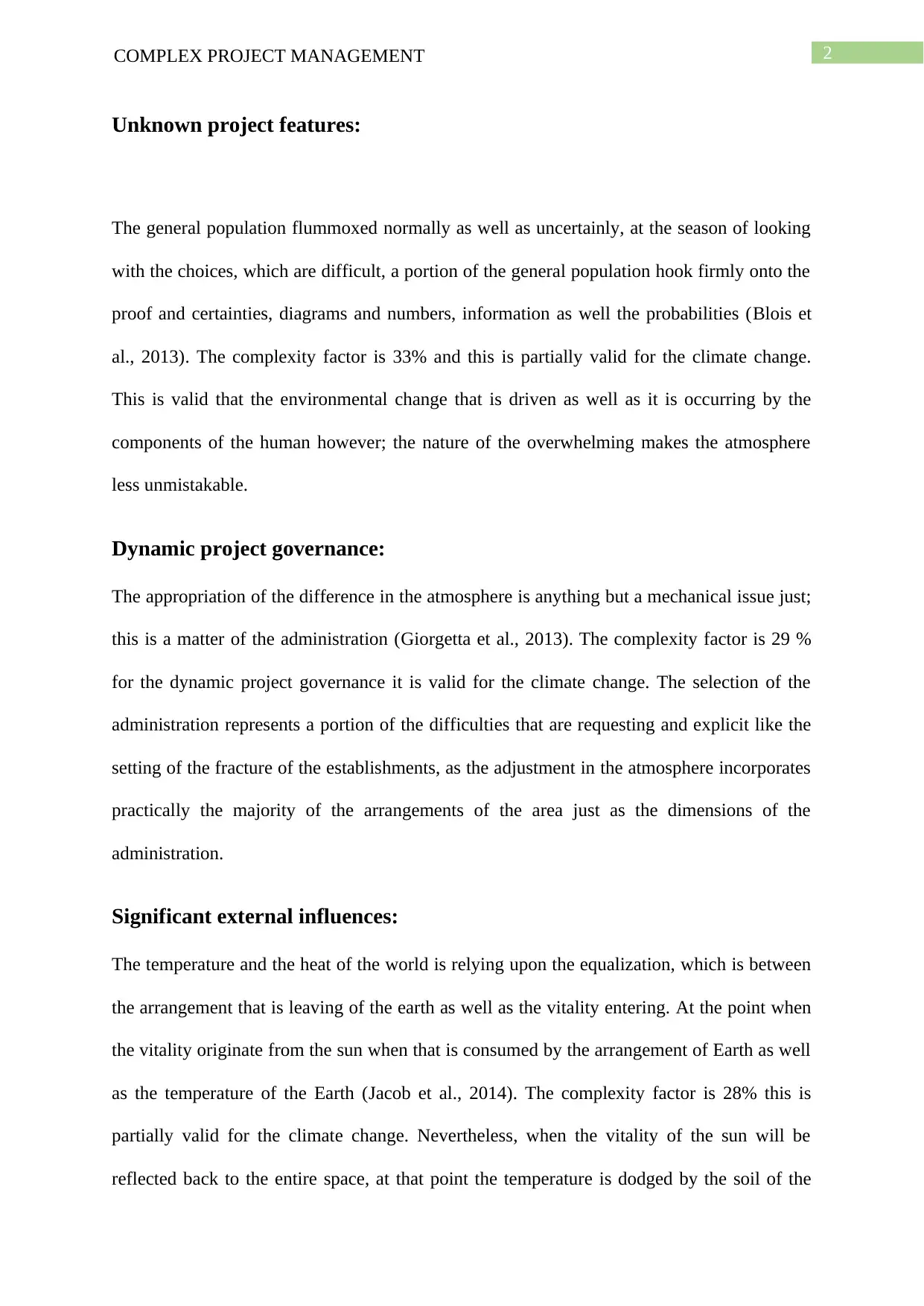
2COMPLEX PROJECT MANAGEMENT
Unknown project features:
The general population flummoxed normally as well as uncertainly, at the season of looking
with the choices, which are difficult, a portion of the general population hook firmly onto the
proof and certainties, diagrams and numbers, information as well the probabilities (Blois et
al., 2013). The complexity factor is 33% and this is partially valid for the climate change.
This is valid that the environmental change that is driven as well as it is occurring by the
components of the human however; the nature of the overwhelming makes the atmosphere
less unmistakable.
Dynamic project governance:
The appropriation of the difference in the atmosphere is anything but a mechanical issue just;
this is a matter of the administration (Giorgetta et al., 2013). The complexity factor is 29 %
for the dynamic project governance it is valid for the climate change. The selection of the
administration represents a portion of the difficulties that are requesting and explicit like the
setting of the fracture of the establishments, as the adjustment in the atmosphere incorporates
practically the majority of the arrangements of the area just as the dimensions of the
administration.
Significant external influences:
The temperature and the heat of the world is relying upon the equalization, which is between
the arrangement that is leaving of the earth as well as the vitality entering. At the point when
the vitality originate from the sun when that is consumed by the arrangement of Earth as well
as the temperature of the Earth (Jacob et al., 2014). The complexity factor is 28% this is
partially valid for the climate change. Nevertheless, when the vitality of the sun will be
reflected back to the entire space, at that point the temperature is dodged by the soil of the
Unknown project features:
The general population flummoxed normally as well as uncertainly, at the season of looking
with the choices, which are difficult, a portion of the general population hook firmly onto the
proof and certainties, diagrams and numbers, information as well the probabilities (Blois et
al., 2013). The complexity factor is 33% and this is partially valid for the climate change.
This is valid that the environmental change that is driven as well as it is occurring by the
components of the human however; the nature of the overwhelming makes the atmosphere
less unmistakable.
Dynamic project governance:
The appropriation of the difference in the atmosphere is anything but a mechanical issue just;
this is a matter of the administration (Giorgetta et al., 2013). The complexity factor is 29 %
for the dynamic project governance it is valid for the climate change. The selection of the
administration represents a portion of the difficulties that are requesting and explicit like the
setting of the fracture of the establishments, as the adjustment in the atmosphere incorporates
practically the majority of the arrangements of the area just as the dimensions of the
administration.
Significant external influences:
The temperature and the heat of the world is relying upon the equalization, which is between
the arrangement that is leaving of the earth as well as the vitality entering. At the point when
the vitality originate from the sun when that is consumed by the arrangement of Earth as well
as the temperature of the Earth (Jacob et al., 2014). The complexity factor is 28% this is
partially valid for the climate change. Nevertheless, when the vitality of the sun will be
reflected back to the entire space, at that point the temperature is dodged by the soil of the
You're viewing a preview
Unlock full access by subscribing today!
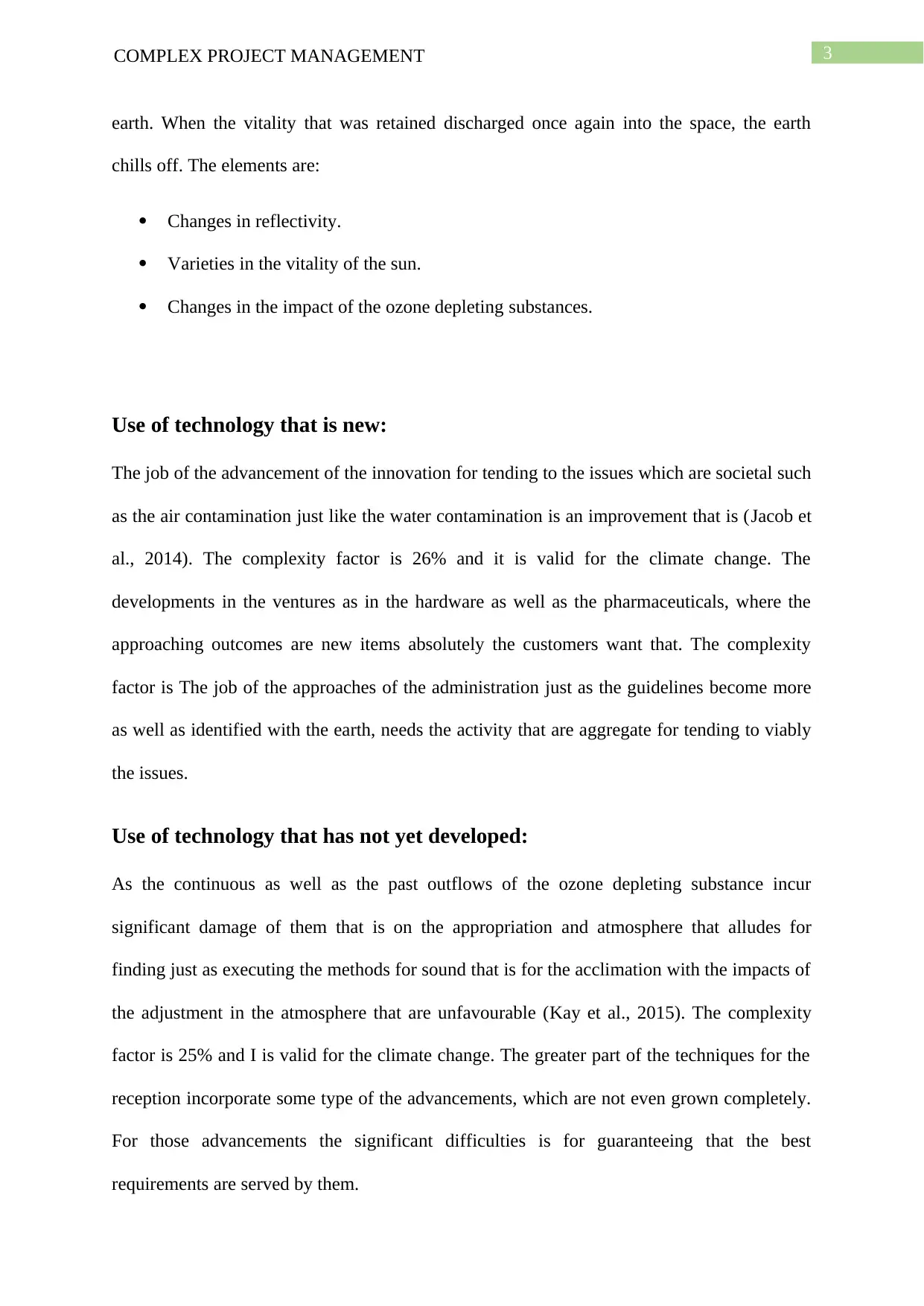
3COMPLEX PROJECT MANAGEMENT
earth. When the vitality that was retained discharged once again into the space, the earth
chills off. The elements are:
Changes in reflectivity.
Varieties in the vitality of the sun.
Changes in the impact of the ozone depleting substances.
Use of technology that is new:
The job of the advancement of the innovation for tending to the issues which are societal such
as the air contamination just like the water contamination is an improvement that is (Jacob et
al., 2014). The complexity factor is 26% and it is valid for the climate change. The
developments in the ventures as in the hardware as well as the pharmaceuticals, where the
approaching outcomes are new items absolutely the customers want that. The complexity
factor is The job of the approaches of the administration just as the guidelines become more
as well as identified with the earth, needs the activity that are aggregate for tending to viably
the issues.
Use of technology that has not yet developed:
As the continuous as well as the past outflows of the ozone depleting substance incur
significant damage of them that is on the appropriation and atmosphere that alludes for
finding just as executing the methods for sound that is for the acclimation with the impacts of
the adjustment in the atmosphere that are unfavourable (Kay et al., 2015). The complexity
factor is 25% and I is valid for the climate change. The greater part of the techniques for the
reception incorporate some type of the advancements, which are not even grown completely.
For those advancements the significant difficulties is for guaranteeing that the best
requirements are served by them.
earth. When the vitality that was retained discharged once again into the space, the earth
chills off. The elements are:
Changes in reflectivity.
Varieties in the vitality of the sun.
Changes in the impact of the ozone depleting substances.
Use of technology that is new:
The job of the advancement of the innovation for tending to the issues which are societal such
as the air contamination just like the water contamination is an improvement that is (Jacob et
al., 2014). The complexity factor is 26% and it is valid for the climate change. The
developments in the ventures as in the hardware as well as the pharmaceuticals, where the
approaching outcomes are new items absolutely the customers want that. The complexity
factor is The job of the approaches of the administration just as the guidelines become more
as well as identified with the earth, needs the activity that are aggregate for tending to viably
the issues.
Use of technology that has not yet developed:
As the continuous as well as the past outflows of the ozone depleting substance incur
significant damage of them that is on the appropriation and atmosphere that alludes for
finding just as executing the methods for sound that is for the acclimation with the impacts of
the adjustment in the atmosphere that are unfavourable (Kay et al., 2015). The complexity
factor is 25% and I is valid for the climate change. The greater part of the techniques for the
reception incorporate some type of the advancements, which are not even grown completely.
For those advancements the significant difficulties is for guaranteeing that the best
requirements are served by them.
Paraphrase This Document
Need a fresh take? Get an instant paraphrase of this document with our AI Paraphraser
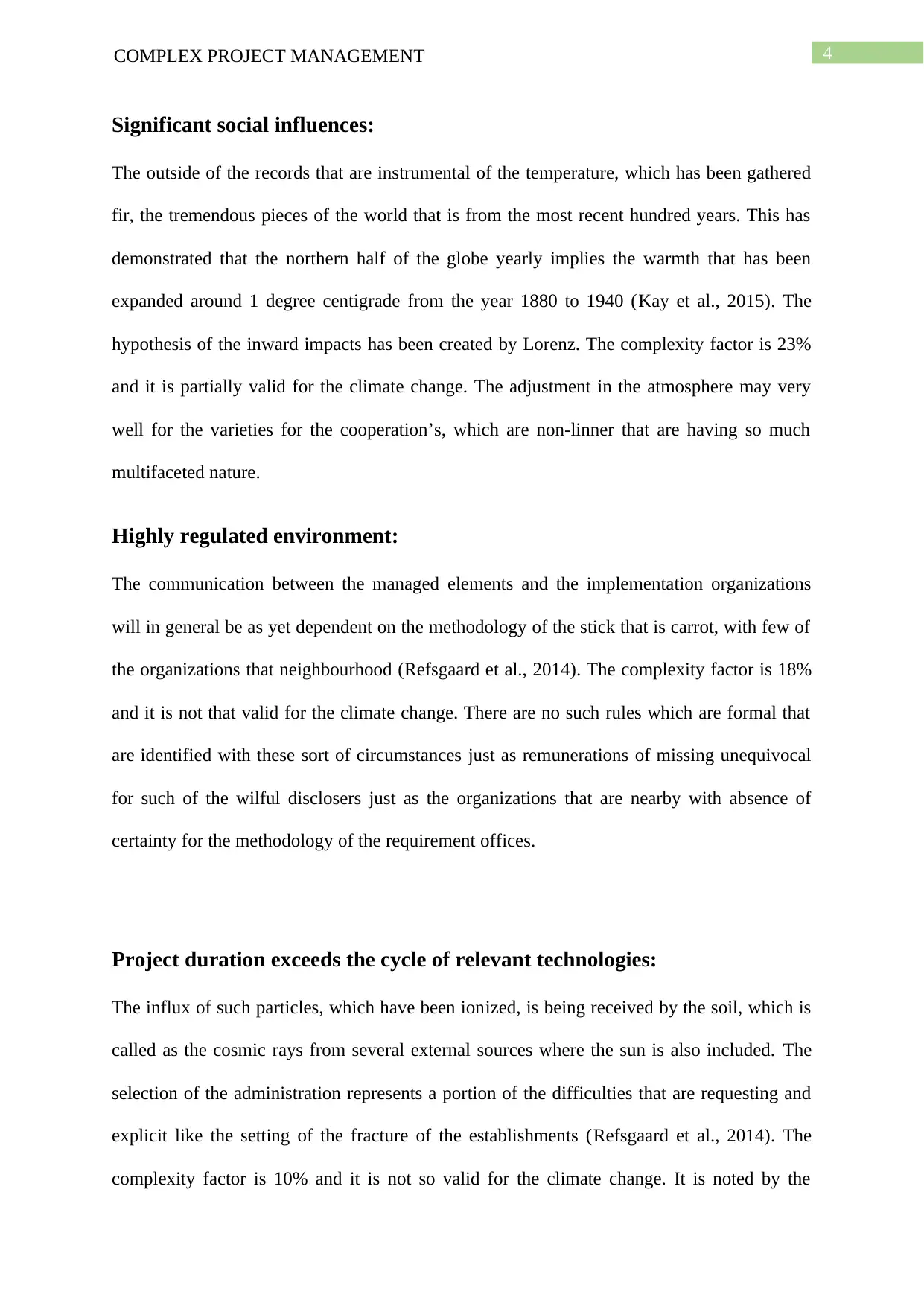
4COMPLEX PROJECT MANAGEMENT
Significant social influences:
The outside of the records that are instrumental of the temperature, which has been gathered
fir, the tremendous pieces of the world that is from the most recent hundred years. This has
demonstrated that the northern half of the globe yearly implies the warmth that has been
expanded around 1 degree centigrade from the year 1880 to 1940 (Kay et al., 2015). The
hypothesis of the inward impacts has been created by Lorenz. The complexity factor is 23%
and it is partially valid for the climate change. The adjustment in the atmosphere may very
well for the varieties for the cooperation’s, which are non-linner that are having so much
multifaceted nature.
Highly regulated environment:
The communication between the managed elements and the implementation organizations
will in general be as yet dependent on the methodology of the stick that is carrot, with few of
the organizations that neighbourhood (Refsgaard et al., 2014). The complexity factor is 18%
and it is not that valid for the climate change. There are no such rules which are formal that
are identified with these sort of circumstances just as remunerations of missing unequivocal
for such of the wilful disclosers just as the organizations that are nearby with absence of
certainty for the methodology of the requirement offices.
Project duration exceeds the cycle of relevant technologies:
The influx of such particles, which have been ionized, is being received by the soil, which is
called as the cosmic rays from several external sources where the sun is also included. The
selection of the administration represents a portion of the difficulties that are requesting and
explicit like the setting of the fracture of the establishments (Refsgaard et al., 2014). The
complexity factor is 10% and it is not so valid for the climate change. It is noted by the
Significant social influences:
The outside of the records that are instrumental of the temperature, which has been gathered
fir, the tremendous pieces of the world that is from the most recent hundred years. This has
demonstrated that the northern half of the globe yearly implies the warmth that has been
expanded around 1 degree centigrade from the year 1880 to 1940 (Kay et al., 2015). The
hypothesis of the inward impacts has been created by Lorenz. The complexity factor is 23%
and it is partially valid for the climate change. The adjustment in the atmosphere may very
well for the varieties for the cooperation’s, which are non-linner that are having so much
multifaceted nature.
Highly regulated environment:
The communication between the managed elements and the implementation organizations
will in general be as yet dependent on the methodology of the stick that is carrot, with few of
the organizations that neighbourhood (Refsgaard et al., 2014). The complexity factor is 18%
and it is not that valid for the climate change. There are no such rules which are formal that
are identified with these sort of circumstances just as remunerations of missing unequivocal
for such of the wilful disclosers just as the organizations that are nearby with absence of
certainty for the methodology of the requirement offices.
Project duration exceeds the cycle of relevant technologies:
The influx of such particles, which have been ionized, is being received by the soil, which is
called as the cosmic rays from several external sources where the sun is also included. The
selection of the administration represents a portion of the difficulties that are requesting and
explicit like the setting of the fracture of the establishments (Refsgaard et al., 2014). The
complexity factor is 10% and it is not so valid for the climate change. It is noted by the

5COMPLEX PROJECT MANAGEMENT
scholars that the discretion of the delegate states to the organizations that are specialized for
performing a task on the behalf of them. The adoption of the poses of the governance, several
challenges also exist there.
scholars that the discretion of the delegate states to the organizations that are specialized for
performing a task on the behalf of them. The adoption of the poses of the governance, several
challenges also exist there.
You're viewing a preview
Unlock full access by subscribing today!

6COMPLEX PROJECT MANAGEMENT
Rader diagram:
Multiple stakeholders
Ambiguity of project features
Significant political influences
Unknown project features
Dynamic peoject governance
Significant external influences
Use of technology
Social influences
Highly regulated environment
Project duration exceeds the cycle
0%
50%
100%
Climate change
Rader diagram:
Multiple stakeholders
Ambiguity of project features
Significant political influences
Unknown project features
Dynamic peoject governance
Significant external influences
Use of technology
Social influences
Highly regulated environment
Project duration exceeds the cycle
0%
50%
100%
Climate change
Paraphrase This Document
Need a fresh take? Get an instant paraphrase of this document with our AI Paraphraser
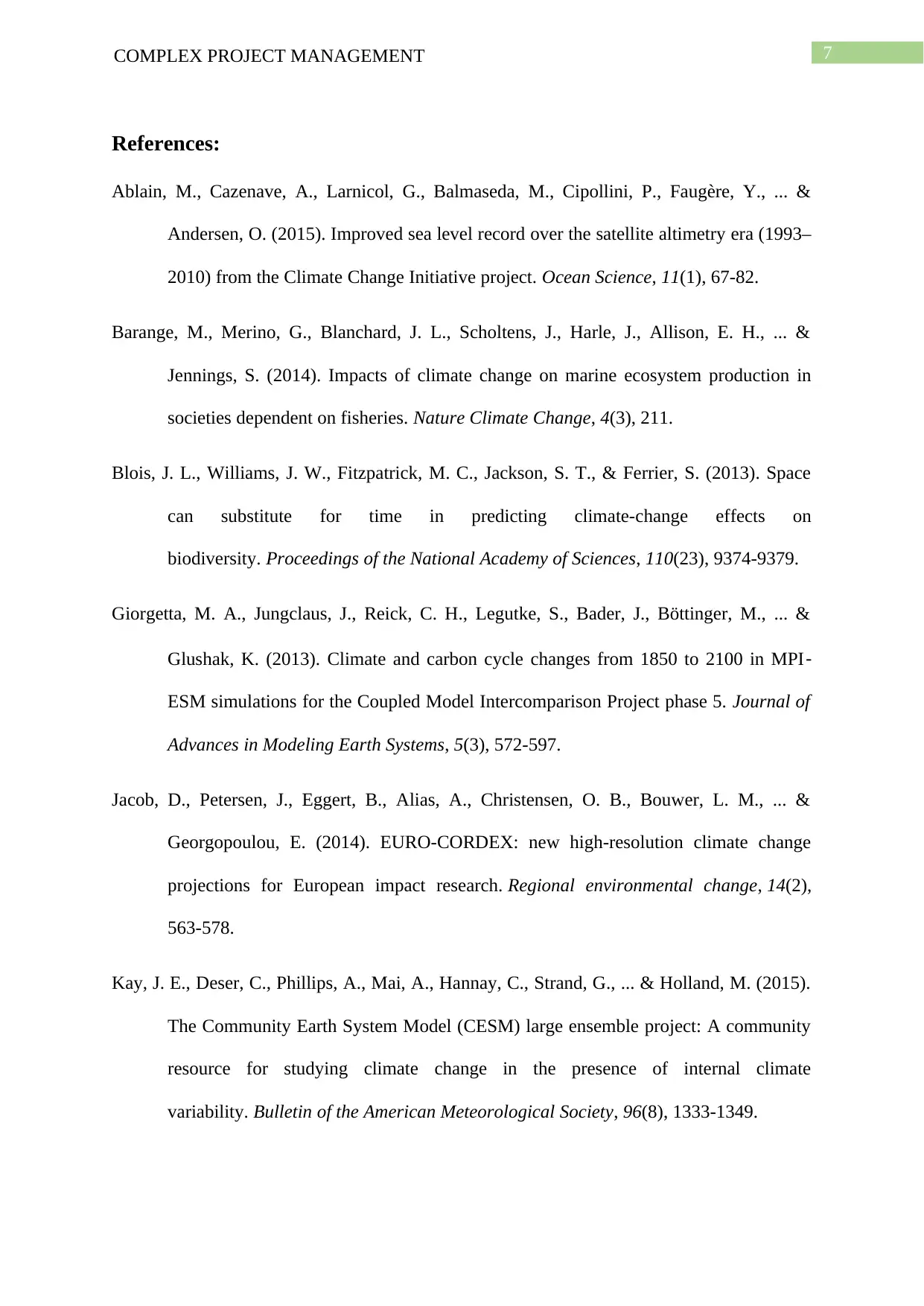
7COMPLEX PROJECT MANAGEMENT
References:
Ablain, M., Cazenave, A., Larnicol, G., Balmaseda, M., Cipollini, P., Faugère, Y., ... &
Andersen, O. (2015). Improved sea level record over the satellite altimetry era (1993–
2010) from the Climate Change Initiative project. Ocean Science, 11(1), 67-82.
Barange, M., Merino, G., Blanchard, J. L., Scholtens, J., Harle, J., Allison, E. H., ... &
Jennings, S. (2014). Impacts of climate change on marine ecosystem production in
societies dependent on fisheries. Nature Climate Change, 4(3), 211.
Blois, J. L., Williams, J. W., Fitzpatrick, M. C., Jackson, S. T., & Ferrier, S. (2013). Space
can substitute for time in predicting climate-change effects on
biodiversity. Proceedings of the National Academy of Sciences, 110(23), 9374-9379.
Giorgetta, M. A., Jungclaus, J., Reick, C. H., Legutke, S., Bader, J., Böttinger, M., ... &
Glushak, K. (2013). Climate and carbon cycle changes from 1850 to 2100 in MPI‐
ESM simulations for the Coupled Model Intercomparison Project phase 5. Journal of
Advances in Modeling Earth Systems, 5(3), 572-597.
Jacob, D., Petersen, J., Eggert, B., Alias, A., Christensen, O. B., Bouwer, L. M., ... &
Georgopoulou, E. (2014). EURO-CORDEX: new high-resolution climate change
projections for European impact research. Regional environmental change, 14(2),
563-578.
Kay, J. E., Deser, C., Phillips, A., Mai, A., Hannay, C., Strand, G., ... & Holland, M. (2015).
The Community Earth System Model (CESM) large ensemble project: A community
resource for studying climate change in the presence of internal climate
variability. Bulletin of the American Meteorological Society, 96(8), 1333-1349.
References:
Ablain, M., Cazenave, A., Larnicol, G., Balmaseda, M., Cipollini, P., Faugère, Y., ... &
Andersen, O. (2015). Improved sea level record over the satellite altimetry era (1993–
2010) from the Climate Change Initiative project. Ocean Science, 11(1), 67-82.
Barange, M., Merino, G., Blanchard, J. L., Scholtens, J., Harle, J., Allison, E. H., ... &
Jennings, S. (2014). Impacts of climate change on marine ecosystem production in
societies dependent on fisheries. Nature Climate Change, 4(3), 211.
Blois, J. L., Williams, J. W., Fitzpatrick, M. C., Jackson, S. T., & Ferrier, S. (2013). Space
can substitute for time in predicting climate-change effects on
biodiversity. Proceedings of the National Academy of Sciences, 110(23), 9374-9379.
Giorgetta, M. A., Jungclaus, J., Reick, C. H., Legutke, S., Bader, J., Böttinger, M., ... &
Glushak, K. (2013). Climate and carbon cycle changes from 1850 to 2100 in MPI‐
ESM simulations for the Coupled Model Intercomparison Project phase 5. Journal of
Advances in Modeling Earth Systems, 5(3), 572-597.
Jacob, D., Petersen, J., Eggert, B., Alias, A., Christensen, O. B., Bouwer, L. M., ... &
Georgopoulou, E. (2014). EURO-CORDEX: new high-resolution climate change
projections for European impact research. Regional environmental change, 14(2),
563-578.
Kay, J. E., Deser, C., Phillips, A., Mai, A., Hannay, C., Strand, G., ... & Holland, M. (2015).
The Community Earth System Model (CESM) large ensemble project: A community
resource for studying climate change in the presence of internal climate
variability. Bulletin of the American Meteorological Society, 96(8), 1333-1349.
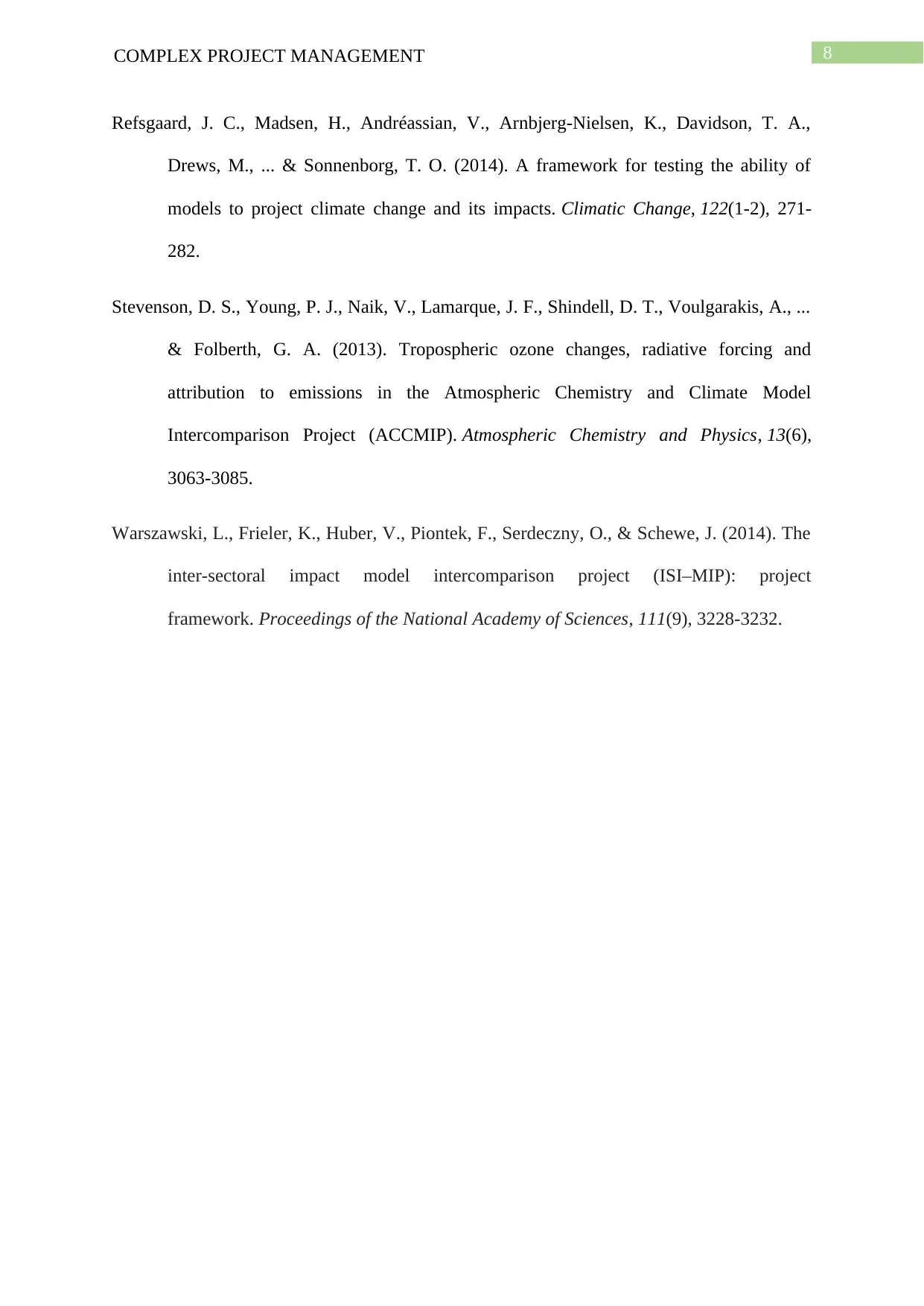
8COMPLEX PROJECT MANAGEMENT
Refsgaard, J. C., Madsen, H., Andréassian, V., Arnbjerg-Nielsen, K., Davidson, T. A.,
Drews, M., ... & Sonnenborg, T. O. (2014). A framework for testing the ability of
models to project climate change and its impacts. Climatic Change, 122(1-2), 271-
282.
Stevenson, D. S., Young, P. J., Naik, V., Lamarque, J. F., Shindell, D. T., Voulgarakis, A., ...
& Folberth, G. A. (2013). Tropospheric ozone changes, radiative forcing and
attribution to emissions in the Atmospheric Chemistry and Climate Model
Intercomparison Project (ACCMIP). Atmospheric Chemistry and Physics, 13(6),
3063-3085.
Warszawski, L., Frieler, K., Huber, V., Piontek, F., Serdeczny, O., & Schewe, J. (2014). The
inter-sectoral impact model intercomparison project (ISI–MIP): project
framework. Proceedings of the National Academy of Sciences, 111(9), 3228-3232.
Refsgaard, J. C., Madsen, H., Andréassian, V., Arnbjerg-Nielsen, K., Davidson, T. A.,
Drews, M., ... & Sonnenborg, T. O. (2014). A framework for testing the ability of
models to project climate change and its impacts. Climatic Change, 122(1-2), 271-
282.
Stevenson, D. S., Young, P. J., Naik, V., Lamarque, J. F., Shindell, D. T., Voulgarakis, A., ...
& Folberth, G. A. (2013). Tropospheric ozone changes, radiative forcing and
attribution to emissions in the Atmospheric Chemistry and Climate Model
Intercomparison Project (ACCMIP). Atmospheric Chemistry and Physics, 13(6),
3063-3085.
Warszawski, L., Frieler, K., Huber, V., Piontek, F., Serdeczny, O., & Schewe, J. (2014). The
inter-sectoral impact model intercomparison project (ISI–MIP): project
framework. Proceedings of the National Academy of Sciences, 111(9), 3228-3232.
You're viewing a preview
Unlock full access by subscribing today!
1 out of 9
Related Documents
Your All-in-One AI-Powered Toolkit for Academic Success.
+13062052269
info@desklib.com
Available 24*7 on WhatsApp / Email
![[object Object]](/_next/static/media/star-bottom.7253800d.svg)
Unlock your academic potential
© 2024 | Zucol Services PVT LTD | All rights reserved.





